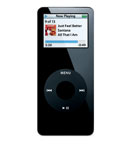Business
Why the 1GB iPod won't do video; RIP shuffle?
In a suprise Tuesday announcement Apple released a 1GB version of their popular iPod nano (US$149) that will hold up to 240 songs or 15,000 photos. At the same time Apple dropped the price of the iPod shuffle to US$69 and US$99.


In my Macworld Expo article I predicted that Apple would release a 1GB iPod nano and euthanize the shuffle (like they did with the iPod mini). The couple extra bucks the nano commands is a bargain considering that you get a color screen with photo playback and a dock connector for connecting accessories. I also speculated that Apple would add video playback support to the nano line via a firmware upgrade (to boost sales of TV shows and video content) but it turns out that it's not possible.
In a January article on the PowerPage I posted a couple of reasons why the nano won't do video: The iPod Video has two CPUs. One generic CPU running at ~75Mhz (which is the same as all iPods) and a specialized video DSP running at ~150 MHz that is able to decode h.264 video in real-time. The video playback only uses that DSP and not the main CPU. No other iPod model other than the video has this DSP in it making video playback impossible on the nano.
We can deduce from the 1Gb nano announcement that the end is near for the iPod shuffle. There's just no reason to keep it around with its stripped feature set and low profit margins. Don't be surprised when the nano gets upgraded to 8GB and 16GB capacities in the late summer/early fall.
1GB nanos are perfect for Valentine's day, but 8GB and 16GB nanos would be killer for back-to-school.